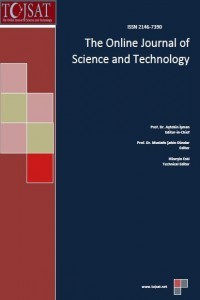The Effects of Nature Education Project on the Environmental Sensitivity
The Effects of Nature Education Project on the Environmental Sensitivity
___
- Atasoy, Emin & Ertürk, Hasan. (2008). İlköğretim öğrencilerinin çevresel tutum ve çevre bilgisi üzerine bir alan araştırması. Erzincan Eğitim Fakültesi Dergisi, 10(1).
- Aydın, F. & Kaya, H. (2011). Sosyal Bilimler Lisesi Öğrencilerinin Çevre Duyarlılıklarının Değerlendirilmesi, Marmara Coğrafya Dergisi, 24: 229-257.
- Çabuk, B. & Karacaoğlu, C. (2003). Üniversite Öğrencilerinin Çevre Duyarlılıklarının İncelenmesi. Ankara Üniversitesi Eğitim Bilimleri Fakültesi Dergisi, 36(1,2): 189-198.
- Dresner, M. & Gill, M. (1994). Environmental education at summer nature camp. Journal of Environmental Education, 25(3): 35-41.
- Erten, S. (2005). Okul Öncesi Öğretmen Adaylarında Çevre Dostu Davranışların Araştırılması, Hacettepe Üniversitesi Eğitim Fakültesi Dergisi, 28: 92-100.
- Erten, S.(2004). Uluslararası Düzeyde Yükselen Bir Değer Olarak Biyolojik Çeşitlilik, Hacettepe Üniversitesi Eğitim Fakültesi Dergisi, 27: 98-105.
- Farmer, J., Knapp, D.,& Benton, M. G. (2007). “An elementary school environmental education field trip: long-term effects on ecological and environmental knowledge and attitude development”. The Journal of Environmental Education. Reports&Research, Spring 2007, 38(3): 33-42.
- Hungerfordh., L., Peytonr, R. & Yolk, T. (1992) Investigating and Evaluating Environmental Issues and Actions: skill development modules (Champaign, IL, Stipes).
- Kahyaoğlu, M., Daban, Ş. & Yangın, S. (2008). İlköğretim Öğretmen Adaylarının Çevreye Yönelik Tutumları, D.Ü.Ziya Gökalp Eğitim Fakültesi Dergisi, 11, pp.42-52.
- Ozaner, F. S. (2004). “Türkiye’de okul dışı çevre eğitimi ne durumda ve neler yapılmalı?” V.Ulusal Ekoloji ve Çevre Kongresi 5-8 Ekim,Taksim International Abant Palace, Abant İzzet Baysal Üniversitesi & Biyologlar Derneği, Abant- Bolu. Bildiri Kitabı (Doğa ve Çevre), 67-98, Biyologlar Derneği, İzmir.
- Özgen, N. (2012). Öğretmen Adaylarının Çevre Sorunlarına Yönelik Tutumları: Türkiye Örneği, Kastamonu Eğitim Dergisi, 20(2): 403-422.
- Palmberg, I.E. & Kuru, J. (2000). Outdoor Activities as a Basis for Environmental Responsibility, The Journal of Environmental Education, 31 (4): 32-6.
- Schmidt, K. F. (1996). Green education under fire. Science, 274: 1828–1830.
- Shepard, C. & Speelman, L. R. (1985-86, Winter). Affecting environmental attitudes through outdoor education. Journal of Environmental Education, 17(2): 20-23.
- Sivek, D. (2002). Environmental Sensitivity among Wisconsin High School Students, Environmental Education Research, 8(2), 155-170.
- ISSN: 2146-7390
- Başlangıç: 2011
- Yayıncı: The association of science, education and technology
Antiviral Activity of Polyphenols Extracts From Daucus carota against Herpes Simplex Virus type 1
Pre-Service Teachers' about the Use of Web Adventure in the Course of Introduction to Computer
An Agent Based Approach for Project Management in Construction
Factors Affecting Leisure Time Activities According to Vocational High School Students
Distribution of salinity and nutrients in soils under recently environment change
Taha EL-MAGHRABY, Mohamed ABDEL-WAHAB
Students understanding of the concept of limit of a function in vocational high school mathematic
The role of using Facebook in improving English
Chemical analysis to identify organic compounds in pre-Columbian monumental earthen architecture
Yuko KİTA, Annick DANEELS, Alfonso Romo De VİVAR
Online Tracking Nutrition and Health of High School Students
